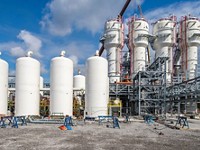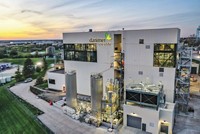Advertisement
Grab your lab coat. Let's get started
Welcome!
Welcome!
Create an account below to get 6 C&EN articles per month, receive newsletters and more - all free.
It seems this is your first time logging in online. Please enter the following information to continue.
As an ACS member you automatically get access to this site. All we need is few more details to create your reading experience.
Not you? Sign in with a different account.
Not you? Sign in with a different account.
ERROR 1
ERROR 1
ERROR 2
ERROR 2
ERROR 2
ERROR 2
ERROR 2
Password and Confirm password must match.
If you have an ACS member number, please enter it here so we can link this account to your membership. (optional)
ERROR 2
ACS values your privacy. By submitting your information, you are gaining access to C&EN and subscribing to our weekly newsletter. We use the information you provide to make your reading experience better, and we will never sell your data to third party members.
Biobased Chemicals
Green chemical maker LanzaTech to go public via merger
Company hopes to avoid pitfalls of other materials firms that listed on the stock market via SPAC deals
by Michael McCoy
March 9, 2022

LanzaTech is the latest green chemical company to announce plans to go public by merging with a special purpose acquisition company, or SPAC. The deal, with AMCI Acquisition Corp. II, will inject some $275 million into LanzaTech’s coffers and value it at about $2.2 billion.
LanzaTech was formed in 2005 to convert carbon-containing waste gases into chemicals. Its CEO since 2010 has been Jennifer Holmgren, a chemist who previously worked at Honeywell UOP for 23 years. Since its founding, LanzaTech has raised over $500 million from venture investors including ArcelorMittal, BASF, and Indian Oil.
The Illinois-based company’s core technology turns emissions from steel mills and other industrial operations into chemicals via microbial fermentation. Its most advanced process converts carbon monoxide to ethanol, but the firm has also made chemicals such as acetone and isopropyl alcohol at pilot scale, Holmgren says. Likewise, she says, the process can be applied to carbon dioxide if hydrogen is present as a microbial energy source.
To date, the technology has been commercialized in two facilities—a steel mill and a ferroalloy plant—operated by China’s Shougang Group. Seven other facilities are under construction, including a $200 million plant in Belgium that will capture CO from an ArcelorMittal steel mill. Overall, LanzaTech says, its partners have invested $800 million in facilities deploying the technology.
LanzaTech also has partnerships with companies like L’Oreal, Coty, and Unilever to make packaging and ingredients for consumer products using captured and recycled carbon emissions as raw materials.
LanzaTech joins three other green materials companies that went public through SPAC mergers in 2020 and 2021. Danimer Scientific makes the biodegradable polymer polyhydroxyalkanoate, PureCycle is building polypropylene recycling plants, and Origin Materials converts wood into precursors for the packaging polymer polyethylene terephthalate.
Materials-oriented SPACs have been marked by high-profile struggles and stock price underperformance, says Anthony Schiavo, research director at the consulting firm Lux Research, in an email.
Following their stock market launches, Danimer and PureCycle were targeted by short sellers that issued broadsides against their technology and growth prospects, seeking to induce stock prices to fall. And their stock prices have indeed fallen. Danimer, for example, trades at about $4 per share, down from a high of almost $58 a little over a year ago.
Despite that track record, LanzaTech’s SPAC is likely to succeed, Schiavo says, in part because the company is more commercially mature and has stronger partnerships than many of its contemporaries.
Holmgren witnessed the SPAC merger rage of 2020 and 2021, but she says such a deal still makes sense for LanzaTech because of the expertise of AMCI, the industrial investment firm sponsoring the SPAC. “We’re getting quite a bit of knowledge,” she says. “AMCI is a company that really understands the steel sector, the heavy industry/mining sector.”
And LanzaTech is distinguished by what Geoff Trukenbrod, its chief financial officer, described on a conference call as the company’s “capital-light” model. Whereas Danimer, PureCycle, and Origin are building their own facilities, LanzaTech licenses its technology to partner companies that build the fermentation plants themselves. LanzaTech makes money by providing engineering and start-up services and, later, consumables like microbes and media.
The firm estimates that revenues will be $65 million this year and $178 million in 2023. By 2026, LanzaTech expects to have revenues of close to $1 billion and more than $400 million in earnings before taxes.
Holmgren says the journey since she joined the company in 2010 has been long but ultimately satisfying. “Most people don’t appreciate what it takes to commercialize a disruptive technology in this sector,” she says. “We have the opportunity to show how exponential growth happens after you build and commission plants. We are at the inflection point.”




Join the conversation
Contact the reporter
Submit a Letter to the Editor for publication
Engage with us on Twitter